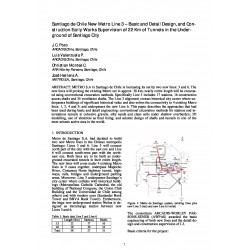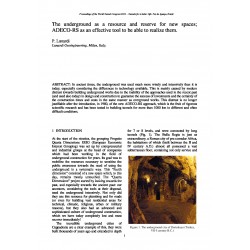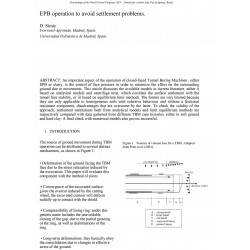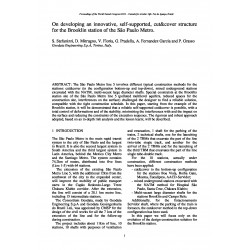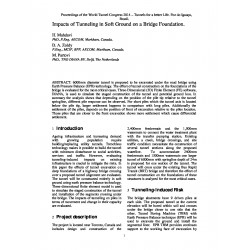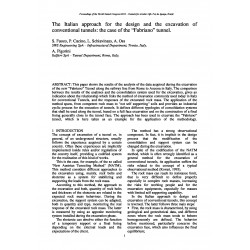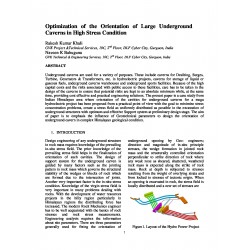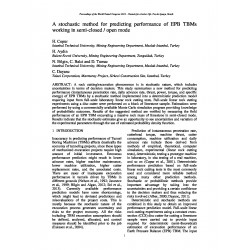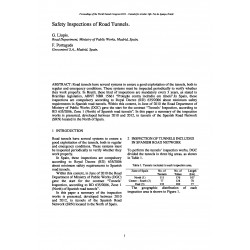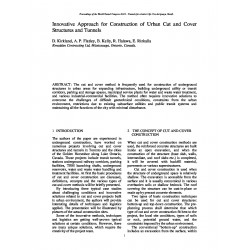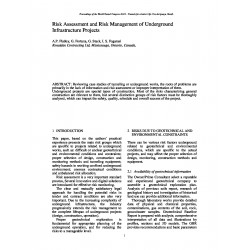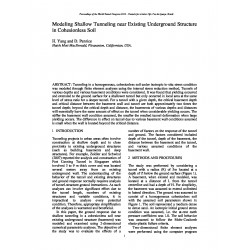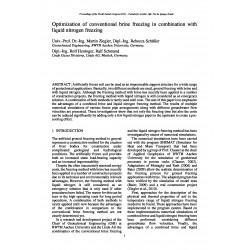No document
Search & filter
Search for a publication
Search & filter
World Tunnelling Congress
WTCThere are 1985 documents.
Risk sharing in tbm tunnel projects in complex geologies
Abstract: Many infrastructure projects, especially hydropower-railway and aqueduct projects, foresee the execution of long tunnels crossing complex geological formation under significant cover. These projects are often executed under EPC contract conditions, with all design and construction risks to be borne by the Contractor. Even by implementing a very extended investigation campaign, it is almost...
0,00 €Immersion Operations of the Coatzacoalcos Tunnel
Abstract: The Coatzacoalcos tunnel in the Mexican state of Veracruz is the first concrete immersed tunnel constructed in Mexico and reaches a depth of more than 30 meters below the water surface. The tunnel links the city of Coatzacoalcos on the westside of the river with the city of Allende and the petrochemical industry on the east side. The roadway tunnel has a total length of 1,200 m and accommodates...
0,00 €Santiago de Chile New Metro Line 3 – Basic and Detail Design, and Construction - Early Works Supervision of 22 Km of...
Abstract: METRO S.A in Santiago de Chile is increasing its net by two new lines: 3 and 6. The new lines will prolong the existing Metro net in approx. 38 km; nearly entire length will be excavated using conventional excavation methods. Specifically Line 3 includes 17 stations, 16 construction access shafts and 34 ventilation shafts. The Line 3 alignment crosses historical city center where underpasses...
0,00 €The underground as a resource and reserve for new spaces - ADECO-RS as an effective tool to be able to realize them
Abstract: In ancient times, the underground was used much more wisely and intensively than it is today, especially considering the differences in technology available. This is mainly caused by modern distrust towards building underground works due to the inability of the approaches used in the recent past (and used also today) in design and construction to guarantee the success of investments and the...
0,00 €EPB operation to avoid settlement problems
Abstract: An important aspect of the operation of closed-faced Tunnel Boring Machines, either EPB or slurry, is the control of face pressure in order to minimize the effect on the surrounding ground due to movements. This article discusses the available models in current literature, either i) based on analytical models and centrifuge tests, which correlate the surface settlement with the tunnel face...
0,00 €On developing an innovative, self-supported, cut and cover structure for the Brooklin station of the São Paulo Metro
Abstract: The São Paulo Metro line 5 involves different typical construction methods for the stations: cut&cover (in the configuration bottom-up and top-down), mined underground stations excavated with the NATM, multi-secant large diameter shafts. Special constraints at the Brooklin station site of the São Paulo Metro line 5 (polluted multilevel aquifers, reduced spaces for the construction site,...
0,00 €Impacts of Tunneling in Soft Ground on a Bridge Foundation
Abstract: 6000mm diameter tunnel is proposed to be excavated under the road bridge using Earth Pressure Balance (EPB) technology. The effect of tunnel construction on the foundations of the bridge is evaluated for the most critical cases. Three-Dimensional (3D) Finite Element (FE) software, DIANA, is used to simulate the staged construction of the tunnel and potential ground loss. In summary the analysis...
0,00 €The Italian approach for the design and the excavation of conventional tunnels: the case of the “Fabriano” tunnel
Abstract: This paper shows the results of the analysis of the data acquired during the excavation of the new “Fabriano” Tunnel along the railway line from Rome to Ancona in Italy. The comparison between the results of the analyses and the consolidation system used for the excavation, gives an indication about the relationship which links the method of excavation commonly used today in Italy for...
0,00 €Optimization of the Orientation of Large Underground Caverns in High Stress Condition
Abstract: Underground caverns are used for a variety of purposes. These include caverns for Desilting, Surges, Turbine, Generators & Transformers, etc. in hydroelectric projects, caverns for storage of liquid or gaseous fuels, underground caverns warehouses and underground sports facilities. Because of the high capital costs and the risks associated with public access to these facilities, care has to be...
0,00 €Pre-planning Methods for the Best Use of Urban Underground Space (UUS)
Abstract: Several cities are in advanced stages of planning, developing and expanding the sub-surface civil and social infrastructure. Many others just consider starting the planned use of UUS (urban underground space). This paper presents a general framework of logical steps for effective pre-planning, exploration and professional management of the underground space. The paper will explain in details...
0,00 €A stochastic method for predicting performance of EPB TBMs working in semi-closed / open mode
Abstract: A rock cutting/excavation phenomenon is in stochastic nature, which includes uncertainties in terms of decision makers. This study summarizes a new method for predicting performance (instantaneous penetration rate, daily advance rate, thrust, power, torque, and specific energy) of EPB TBMs by a stochastic method implemented into a deterministic prediction model requiring input from full-scale...
0,00 €Safety Inspections of Road Tunnels
Abstract: Road tunnels have several systems to ensure a good exploitation of the tunnels, both in regular and emergency conditions. These systems must be inspected periodically to verify whether they work properly. In Brazil, these kind of inspections are mandatory every 3 years, as stated in Brazilian legislation, ABNT NBR 15661 “Proteção contra incêndio em túneis”.In Spain, these inspections are...
0,00 €Innovative Approach for Construction of Urban Cut and Cover Structures and Tunnels
Abstract: The cut and cover method is frequently used for construction of underground structures in urban areas for expanding infrastructure, building underground utility or transit corridors, parking and storage spaces, municipal service plants for water and waste water treatment, and various industrial-commercial facilities. The method often requires innovative solutions to overcome the challenges of...
0,00 €Risk Assessment and Risk Management of Underground Infrastructure Projects
Abstract: Reviewing case studies of tunneling or underground works, the roots of problems are primarily in the lack of information and risk assessment or improper interpretation of them. Underground projects are special types of construction. Most of the risks characterizing general construction are relevant to them, but several distinctive groups of risk factors must be thoroughly analyzed, which can...
0,00 €Modeling Shallow Tunneling near Existing Underground Structure in Cohesionless Soil
Abstract: Tunneling in a homogeneous, cohesionless soil under isotropic in-situ stress condition was modeled through finite element analyses using the internal stress reduction method. Tunnels of various depths and various basement conditions were considered. It was found that yielding occurred and extended to the ground surface for a shallower tunnel but only occurred in local area at the same level of...
0,00 €Optimization of conventional brine freezing in combination with liquid nitrogen freezing
Abstract: Artificially frozen soil can be used as an impermeable support structure for a wide range of geotechnical applications. Basically, two different methods are used, ground freezing with brine and with liquid nitrogen. Although the freezing method with brine has recently been applied in a number of construction projects, the freezing method with liquid nitrogen is still considered as an emergency...
0,00 €



